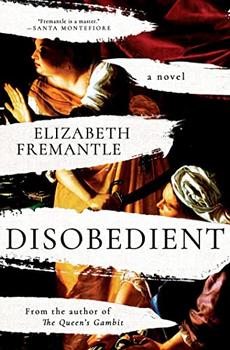Summary | Excerpt | Reviews | Beyond the Book | Read-Alikes | Genres & Themes | Author Bio

A Novel
by Elizabeth FremantleThis article relates to Disobedient
 Judith Slaying Holofernes — also referred to as Judith Beheading Holofernes — is widely considered the masterpiece of Italian Baroque artist Artemisia Gentileschi (1593-c.1656), the protagonist of Elizabeth Fremantle's novel Disobedient. It depicts the Biblical tale of the widowed Israelite Judith, with the help of her maidservant Abra, killing the Assyrian general to free her people from his siege on the city of Bethulia.
Judith Slaying Holofernes — also referred to as Judith Beheading Holofernes — is widely considered the masterpiece of Italian Baroque artist Artemisia Gentileschi (1593-c.1656), the protagonist of Elizabeth Fremantle's novel Disobedient. It depicts the Biblical tale of the widowed Israelite Judith, with the help of her maidservant Abra, killing the Assyrian general to free her people from his siege on the city of Bethulia.
The tale of Judith was popular among artists at the time, but Gentileschi's depiction is noted for being perhaps the most graphic and realistic ever put to canvas, with a marked emphasis on the physical strength and mental determination of her heroine, as well as the resulting bloodshed.
 There are, in fact, two versions of this iconic work. The first, produced sometime between 1611 and 1613, is now held in the Capodimonte Museum in Naples. The second, painted c. 1620, is housed in the Uffizi Gallery in Florence. Differences between the two are small yet significant, showcasing improvements Gentileschi had made in her use of composition, proportion, and color over the years. Her depiction of the fabrics, for example, is richer in the second version, and Holofernes' blood is more vivid and lifelike. The sword, now longer and held vertically, bears a striking resemblance to a cross, while Judith's clenched fist now forms the center axis of the canvas, emphasizing her strength.
There are, in fact, two versions of this iconic work. The first, produced sometime between 1611 and 1613, is now held in the Capodimonte Museum in Naples. The second, painted c. 1620, is housed in the Uffizi Gallery in Florence. Differences between the two are small yet significant, showcasing improvements Gentileschi had made in her use of composition, proportion, and color over the years. Her depiction of the fabrics, for example, is richer in the second version, and Holofernes' blood is more vivid and lifelike. The sword, now longer and held vertically, bears a striking resemblance to a cross, while Judith's clenched fist now forms the center axis of the canvas, emphasizing her strength.
Discussion over the works' origins and their feminist significance continues to this day. Gentileschi explored themes of women and power throughout her entire career, but many see Judith's violent vengeance as a direct response to the sexual assault the artist endured at the age of 17, which took place shortly before she produced the first version of the painting. Gentileschi would face public shame, and be forced to withstand torture in court in a bid to clear her name and send her attacker to prison.
For many critics, it's impossible to ignore the thematic parallels between Gentileschi's own turmoil and the subject matter she chose to explore: a woman enacting brutal revenge on a man by violating his body as he lies in his bed. Given similarities in their physical features, there is even debate as to whether Gentileschi employed the technique of self-insertion, with her depiction of Judith intended to be a self-portrait. If true, this would add even greater weight to the aforementioned theory. Others, however, argue that this reading does a disservice to Gentileschi's artistic talent, imagination, and flair for storytelling in her work. They object to the prospect of her personal tragedies overshadowing her many achievements as an artist, which included royal commissions, international acclaim, and becoming the first woman to be accepted into the Academy of Art and Design in Florence.
In Disobedient, Fremantle aims to strike a balance between these two outlooks on Gentileschi's life and career, with the creation of Judith Slaying Holofernes at the heart of the story. She does so by depicting her as a brilliant artist both because and in spite of her own lived experiences.
Judith Slaying Holofernes by Artemisia Gentileschi, c. 1611-13, courtesy of the National Museum of Capodimonte
Judith Slaying Holofernes by Artemisia Gentileschi, c. 1620, courtesy of the Uffizi
Filed under Music and the Arts
![]() This "beyond the book article" relates to Disobedient. It originally ran in September 2023 and has been updated for the
August 2023 edition.
Go to magazine.
This "beyond the book article" relates to Disobedient. It originally ran in September 2023 and has been updated for the
August 2023 edition.
Go to magazine.
Your guide toexceptional books
BookBrowse seeks out and recommends the best in contemporary fiction and nonfiction—books that not only engage and entertain but also deepen our understanding of ourselves and the world around us.